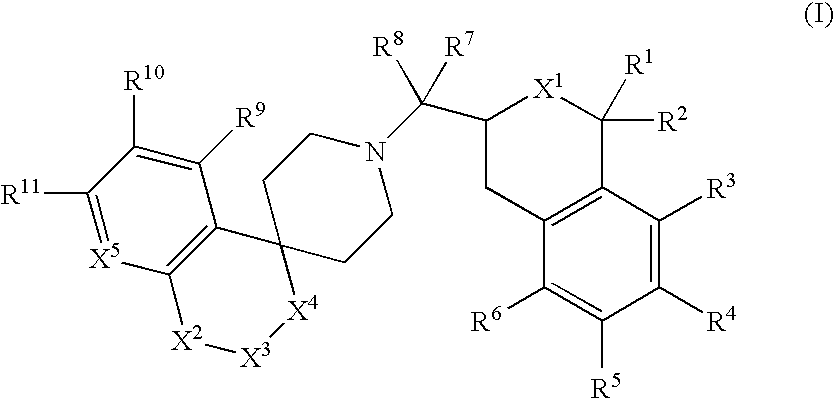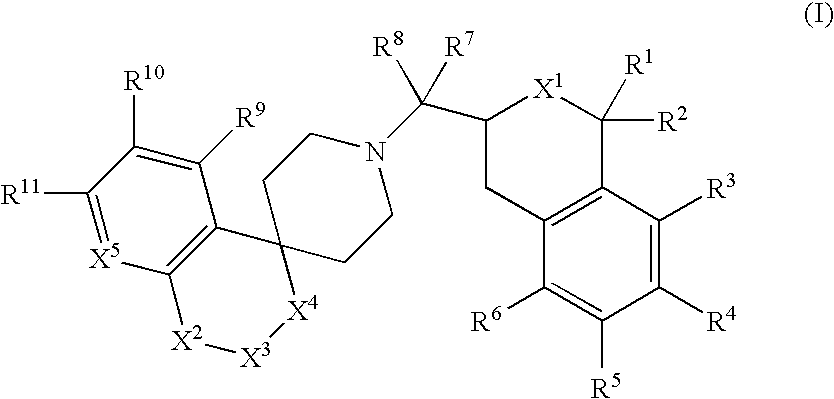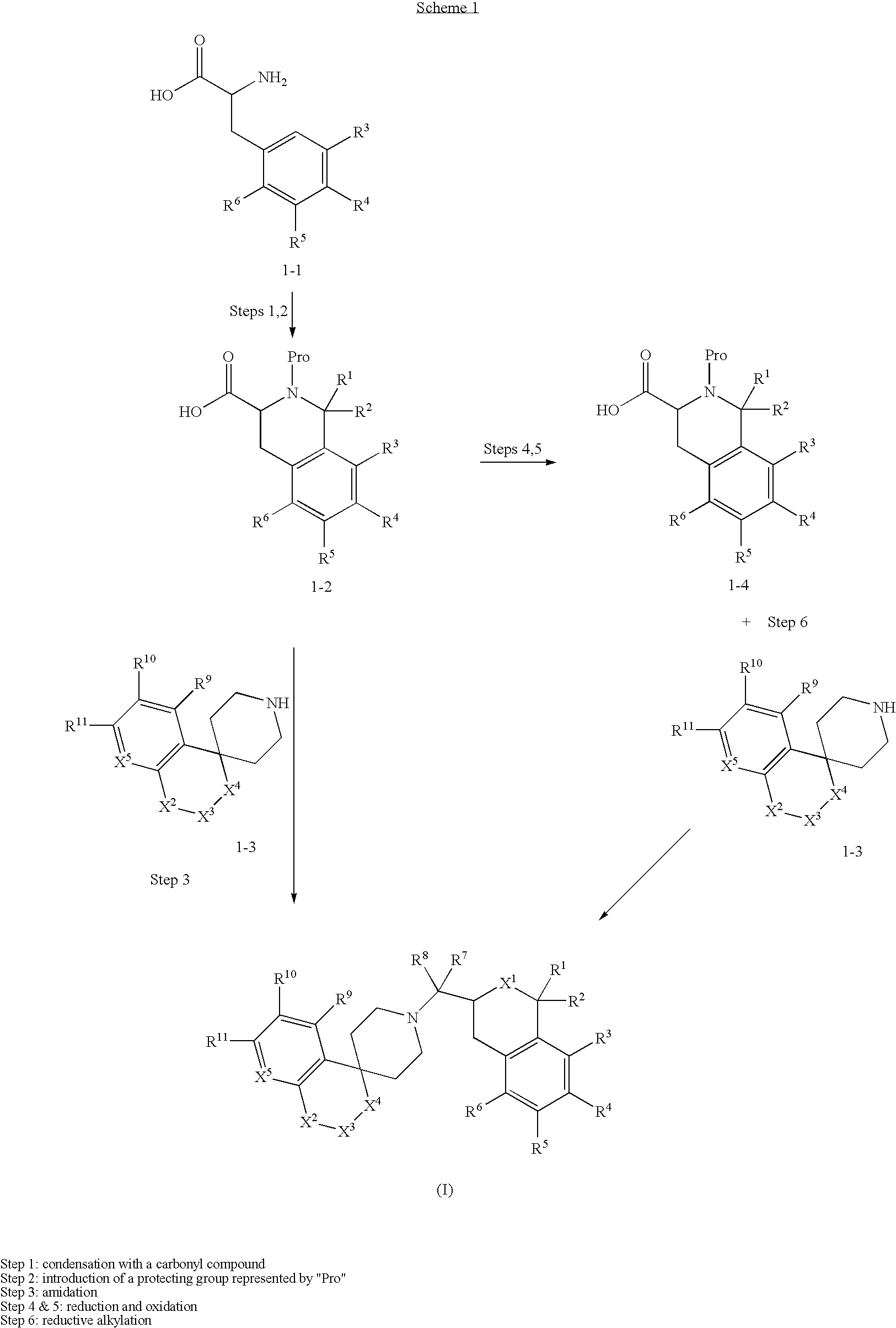Tetrahydroisoquinoline or isochroman compounds
a technology of isochroman and tetrahydroisoquinoline, which is applied in the direction of heterocyclic compound active ingredients, biocide, organic chemistry, etc., can solve the problems of morphine and heroin causing some side effects, and achieve the effects of significant impact on psychosocial and physical function, reducing the quality of life of patients, and increasing sensitivity to noxious stimulus
- Summary
- Abstract
- Description
- Claims
- Application Information
AI Technical Summary
Problems solved by technology
Method used
Image
Examples
example 1
1′-(1,2,3,4-Tetrahydroisoquinolin-3-ylmethyl)-2,3-dihydrospiro[indene-1,4′-piperidine]
(A) tert-Butyl 3-(2,3-dihydro-1′H-spiro[indene-1,4′-piperidin]-1′-ylcarbonyl)-3,4-dihydroisoquinoline-2(1H)-carboxylate
[0247] To a stirred solution of 2-(tert-butoxycarbonyl)-1,2,3,4-tetrahydroisoquinoline-3-carboxylic acid (610.1 mg, 2.2 mmol, this was prepared according to the reported method by S. E. Gibson et al, Bioorg. Med. ChemLett., 1997, 7, 1289), 2,3-dihydrospiro[1H-indene-1,4′-piperidine] hydrochloride (492.2 mg, 2.2 mmol), triethylamine (0.307 mL, 2.2 mmol), and hydroxybenzotriazole (327 mg, 2.42 mmol) in DMF (15 mL) and THF (10 mL) was added WSC (463.9 mg, 2.42 mmol) at −20° C. After 2 days stirring at room temperature, the reaction mixture was poured into aqueous NaHCO3 solution (200 mL) and extracted with ether (100 mL×2). The extracts combined were washed with water (70 mL), dried (MgSO4), filtered, and concentrated. The crude product was purified by silica gel column chromatograph...
example 2
1′-[(2-Acetyl-1,2,3,4-tetrahydroisoquinolin-3-yl)methyl]-2,3-dihydrospiro[indene-1,4′-piperidine]
[0257] To a stirred solution of 1′-(1,2,3,4-tetrahydroisoquinolin-3-ylmethyl)-2,3-dihydrospiro[indene-1,4′-piperidine] (71.7 mg, 0.216 mmol, prepared in Example 1) and triethylamine (0.0753 mL, 0.54 mmol) in CH2Cl2 (2 mL) was added acetyl chloride (0.0154 mL, 0.216 mmol) at room temperature and the resulting reaction mixture was refluxed with stirring for 3 h. The reaction mixture was quenched with water (20 mL) and extracted with CH2Cl2 (25 mL×3). The extracts combined were washed with brine, dried (MgSO4), filtered, and concentrated. The residue was purified by preparative TLC (silica gel plate: CH2Cl2 / methanol:20 / 1) to afford 74.8 mg (92.5%) of title compound.
[0258]1H NMR (300 MHz, CDCl3) δ 7.25-7.08 (8H, m), 5.25-5.15 (0.4H, m), 5.14 (0.6H, d, J=17.8 Hz), 4.64 (0.4H, d, J=16.3 Hz), 4.49 (0.4H, d, J=16.1 Hz), 4.34-4.20 (0.6H, m), 4.25 (0.6H, d, J=18.3 Hz), 3.13-2.64 (6H, m), 2.43-2.3...
example 3
1′-[(2-Methyl-1,2,3,4-tetrahydroisoquinolin-3-yl)methyl]-2,3-dihydrospiro[indene-1,4′-piperidine]
[0262] To a stirred solution of tert-butyl 3-(2,3-dihydro-1′H-spiro[indene-1,4′-piperidin]-1′-ylcarbonyl)-3,4-dihydroisoquinoline-2(1H)-carboxylate (179 mg, 0.4 mmol, prepared in Example 1 (A)) in THF (5 mL) was added LiAlH4 (68.3 mg, 1.8 mmol) at room temperature. After 16 h stirring at room temperature, the reaction mixture was quenched with ethyl acetate (10 mL) at 0° C. After 30 min stirring, water (15 mL) was added to the reaction mixture and stirring was continued another 30 min. The organic layer was separated and the aqueous layer was extracted with ethyl acetate (15 mL×3). The extracts combined were dried (MgSO4), filtered, and concentrated. The crude product was purified by preparative TLC (silica gel plate: CH2Cl2 / methanol: 10 / 1) to afford 61.2 mg (44.2%) of title compound.
[0263]1H NMR (270 MHz, CDCl3) δ 7.25-7.09 (7H, m), 7.06-7.00 (1H, m), 3.84 (1H, d, J=15.8 Hz), 3.74 (1H,...
PUM
| Property | Measurement | Unit |
|---|---|---|
| temperature | aaaaa | aaaaa |
| pressure | aaaaa | aaaaa |
| temperature | aaaaa | aaaaa |
Abstract
Description
Claims
Application Information
 Login to View More
Login to View More - R&D
- Intellectual Property
- Life Sciences
- Materials
- Tech Scout
- Unparalleled Data Quality
- Higher Quality Content
- 60% Fewer Hallucinations
Browse by: Latest US Patents, China's latest patents, Technical Efficacy Thesaurus, Application Domain, Technology Topic, Popular Technical Reports.
© 2025 PatSnap. All rights reserved.Legal|Privacy policy|Modern Slavery Act Transparency Statement|Sitemap|About US| Contact US: help@patsnap.com



